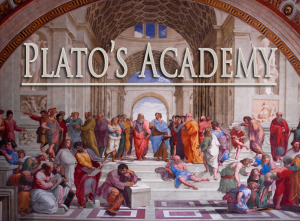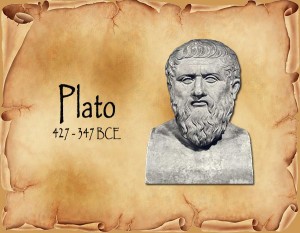Plato was born in 427 B.C. into an aristocratic family on both his mother and father’s side, and died at the age of eighty-one (347 B.C.). Plato (a nickname meaning “broad” and “strong” — whose real name was Aristocles) was wealthy, handsome, and had a superb physique. He was Socrates’ remarkable student, teacher of the brilliant Aristotle, and prodigious writer of philosophical dialogues. Following Socrates’ death in 399 B.C., Plato travelled to southern Italy and spent considerable time with the Pythagorean philosophical school. Upon his return to Athens, he founded the Academy in Athens (385 B.C.) — the first institution of higher learning in the western world. Located in the countryside near Athens and situated in the sacred groves of Acedemus, Plato spent the majority of his life there (except for his excursions to Syracuse) — teaching, writing and researching. His dialogues in the Republic teach us philosophy, logic, politics, ethics, rhetoric, mathematics, and religion. Plato tells us that he was a devoted follower of Socrates (Apology), and we hear the voice of Socrates in the Platonic dialogues.
 The Platonic idea of the immortality of the soul, the preexistence of souls, and that one’s moral position determines one’s accountability in the afterlife are positions that Plato holds, along with Socrates. Platonic philosophy taught that doing an injustice to another was far worse than suffering an abuse unjustly. Socrates teaches us to seek justice, piety, and virtue, which will bring an eternal advantage, because we will be better off in the next world. As we will discuss later in the Republic, the tripartite soul of the individual, i.e., the rational or logical, high-spirited, and appetitive parts of the soul will correspond to the three classes in society, i.e., the guardians, auxiliaries or soldiers, and the merchants living within Plato’s city. The Platonic Theory of Forms holds that what makes an object beautiful is its association with absolute Beauty. There is a Form of Beauty, but this is not what beautiful things have in common, rather it is an exemplar — particular things somehow copy or “participate” in this Form of Beauty. The Forms exist “in the fullest sense”; they have a greater degree of reality than things in the empirical world; they are eternal and unchanging. The reality of the Forms is primary since everything else depends upon their existence.
The Platonic idea of the immortality of the soul, the preexistence of souls, and that one’s moral position determines one’s accountability in the afterlife are positions that Plato holds, along with Socrates. Platonic philosophy taught that doing an injustice to another was far worse than suffering an abuse unjustly. Socrates teaches us to seek justice, piety, and virtue, which will bring an eternal advantage, because we will be better off in the next world. As we will discuss later in the Republic, the tripartite soul of the individual, i.e., the rational or logical, high-spirited, and appetitive parts of the soul will correspond to the three classes in society, i.e., the guardians, auxiliaries or soldiers, and the merchants living within Plato’s city. The Platonic Theory of Forms holds that what makes an object beautiful is its association with absolute Beauty. There is a Form of Beauty, but this is not what beautiful things have in common, rather it is an exemplar — particular things somehow copy or “participate” in this Form of Beauty. The Forms exist “in the fullest sense”; they have a greater degree of reality than things in the empirical world; they are eternal and unchanging. The reality of the Forms is primary since everything else depends upon their existence.
For further information, please purchase a copy of Joan’s book, Socrates, Jesus and Freedom. Copyright © 2016 by Joan Arnsteen

